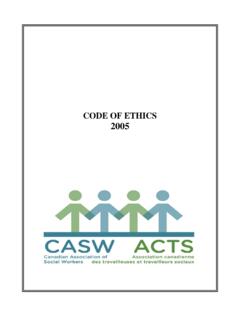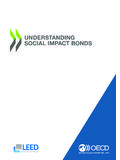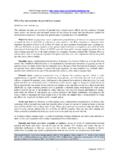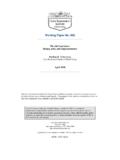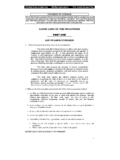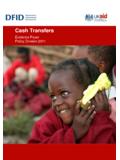Transcription of Universal Basic Income Guarantee The Next ‘BIG’ Thing in
1 Canadian Association of social Workers (CASW) October 2017 Page 1 of 20 Author: Colleen Kennelly Canadian Association of social Workers (CASW) October 2017 Author: Colleen Kennelly Canadian Association of social Workers (CASW) October 2017 Universal Basic Income Guarantee : The Next BIG Thing in Canadian social Policy Canadian Association of social Workers (CASW) October 2017 Page 2 of 20 Founded in 1926 the Canadian Association of social Workers (CASW) is the national association voice for the social work profession. CASW has adopted a pro-active approach to issues pertinent to social policy/ social work. It produces and distributes timely information for its members, and special projects are initiated and sponsored. With its concern for social justice and its continued role in social advocacy, CASW is recognized and called upon both nationally and internationally for its social policy expertise.
2 The mission of CASW is to promote the profession of social work in Canada and advance social justice. CASW is active in the International Federation of social Workers (IFSW). Ce document est disponible en fran ais Canadian Association of social Workers (CASW) October 2017 Page 3 of 20 Introduction Over the past 30 years, there have been so many federal promises to end poverty in Canada, in so many different forms, that it is challenging to provide a detailed list. Yet in 2016, 4 million Canadians ( ) were living in poverty (McIntyre, Kwok, Emery & Dutton, 2016). Despite this historical inability to turn commitments into action, the Canadian Association of social Workers (CASW) believes that now is the time to finally act on these cumulative promises to end poverty. Currently, there is strong public and political support to reduce poverty in Canada by investing in the social determinants of health.
3 Canadians understand that our economic prosperity is directly linked to our investments in reducing the costs of poverty. To provide a few examples of public promises to address the issue of poverty, in 1989 the Canadian House of Commons unanimously passed a motion to end child poverty. In 2015, this motion was revisited, with the House voting in favour of the motion a second time. Canada has also supported the international Sustainable Development Goals, which specify the need to end poverty in all its forms everywhere. In 2009, the Senate Committee on social Affairs, Science and Technology recommended the development of a national poverty plan; the Standing Committee on Human Resources, Skills and social Development and the Status of Persons with Disabilities did the same in 2010. In 2016, the Honourable Jean-Yves Duclos, Minister of Families, Children, and social Development, announced the early stages of development for a national Poverty Reduction Strategy.
4 Moreover, the impetus and philosophy behind strategies such as the Canada Child Benefit, and the Guaranteed Income Supplement, and Old Age Security for seniors, are the same as those proposed in this paper: the values and delivery structure for a new Universal Basic Income Guarantee (what this paper will call the uBIG) are already in place. In this paper, CASW proposes a Basic Income Guarantee in the form of a Universal , tax-free demogrant, available to all Canadians regardless of Income . It will explain why this model is superior to other forms of Basic Income being piloted in Canada today. A uBIG shifts the notion of social security from that of a social safety net to that of an equitable base. While more must be done to address intersecting forms of oppression that contribute to poverty, a uBIG would provide all Canadians with a floor to stand on. In addition to a uBIG, CASW firmly believes that other social determinants of health must also be addressed in a comprehensive plan to truly fulfil the promise of eliminating poverty in Canada.
5 From CASW s perspective, the strengthening of Old Age Security along with the introduction of the Canada Child Benefit in Budget 2016 were solid steps towards realizing a uBIG in Canada. CASW urges the Government of Canada to build on existing political support and seize this moment in history, to continue their national leadership in moving towards a Basic Income Canadian Association of social Workers (CASW) October 2017 Page 4 of 20 Guarantee . A uBIG is a compassionate and fiscally responsible tool through which we can begin to truly move towards a more just and equitable Canada. Additionally, as dialogue around increasing automation and the future of work grows worldwide, the time is now to begin thinking about innovative systems such as uBIG. 1. Rationale For a number of years, CASW has advanced the concepts of equity, accountability, and fairness in the delivery of social investments and services, especially as they relate to the Canada social Transfer (CST).
6 In 2015, CASW proposed the adoption of a social Care Act, with principles similar to those found in the Canada Health Act. These principles include accountability, universality, and portability, to name only a few. In 2016, CASW released The True Cost of Capital, a social work perspective on social investment tools, arguing that Canada can afford to design and implement comprehensive social policies that truly support Canadians and reduce cost in the long term. A uBIG fits seamlessly into both these areas of recommendations by providing an upfront, comprehensive, Universal , and portable benefit to all Canadians in a way that maximizes social engagement and cohesion. A uBIG is an opportunity for the federal government to be at the fore of Canada s next Universal benefit, just as Lester Pearson s government was in enshrining Medicare, something that all Canadians now regard as sacrosanct and key to our national identity.
7 2. Basic Income Defined: Definitions and Models A guaranteed annual Income (GAI) can be defined broadly as an unconditional cash transfer from government to citizens (Lammam & MacIntyre, 2015). While Basic Income Guarantee (BIG) is the current terminology used to describe an unconditional cash transfer from government to citizens in Canada (Mulvale & Frankel, 2016), the terms Basic Income (BI), guaranteed annual Income (GAI), and Basic annual Income (BAI) will be understood as interchangeable throughout this paper. There are three variations or models of a Basic Income Guarantee : the negative Income tax model, the Universal demogrant model ( , uBIG), and the Income top-up model. To date, Basic Income Guarantee experiments within North America have employed the negative Income tax model only (Lammam & MacIntyre, 2015). Within the negative Income tax model, all citizens receive a cash benefit, however this model targets lower Income individuals and families by deducting the product of one s earned Income at the standard reduction rate.
8 In Canada, reduction rates are generally set at 20-70%. As one s alternative Income , namely employment Income , increases, one s Basic benefit decreases. In essence, the more additional Income one earns, the more one s Basic benefit decreases. If the Canadian Association of social Workers (CASW) October 2017 Page 5 of 20 reduction rate is set at 20%, then one s Basic benefit decreases by 20 cents for each additional dollar earned. If the reduction rate is set at 70%, then one s Basic benefit decreases by 70 cents for each additional dollar earned. Critics argue that this model fosters idleness by disrupting incentive structures and motivational drive. Furthermore, the operational costs of employing a program under this model cannot be discounted (Lammam & MacIntyre, 2015). The Universal demogrant model is straight forward all citizens receive the same Basic benefit, regardless of Income .
9 A progressive Income tax system will influence how much of the benefit each individual receives, but it is important to note that all individuals 18 years of age and older are eligible for a tax-free cash sum. The Old Age Security (OAS) pension is an example of an existing Universal demogrant model program as it is given to all individuals 65 years or older, no matter their Income or past earnings (McIntyre et al., 2016). The OAS pension program does not utilize reduction rates, however, once a recipient s Income reaches approximately $73,000 per year, a recovery tax is activated. In light of this, there has been some public debate as to whether or not the OAS pension program is Universal . CASW regards OAS as a Universal demogrant model program, as it does not utilize reduction rates. The Guaranteed Income Supplement (GIS) for seniors is an example of a top-up model program (McIntyre, Dutton, Kwok & Emery, 2015).
10 This model, which makes use of Income testing, calculates one s cash transfer by subtracting one s Income from the Basic benefit. Under this model, individuals whose incomes fall short of the Basic benefit receive a cash transfer bringing them back up to a pre-determined threshold (Lammam & MacIntyre, 2015). The level of this pre-determined threshold is controversial. Advocates for higher Basic benefits argue for the treatment of relative poverty over absolute poverty. Relative poverty relates to Income inequality, whereas absolute poverty relates to one s ability to afford the basics required to live (Lammam & MacIntyre, 2015). The Low Income Measure (LIM) is equal to the median household Income , whereas, the Low Income Cut-Off (LICO) is set to the level at which a household spends or more of its household Income on Basic needs like food and shelter (Canadian Institute for Health Information, 2014).


